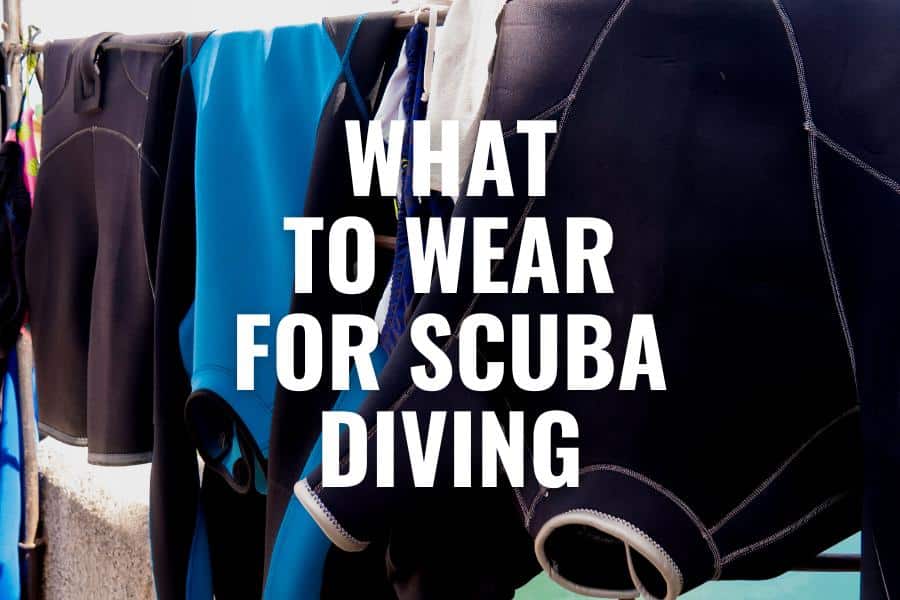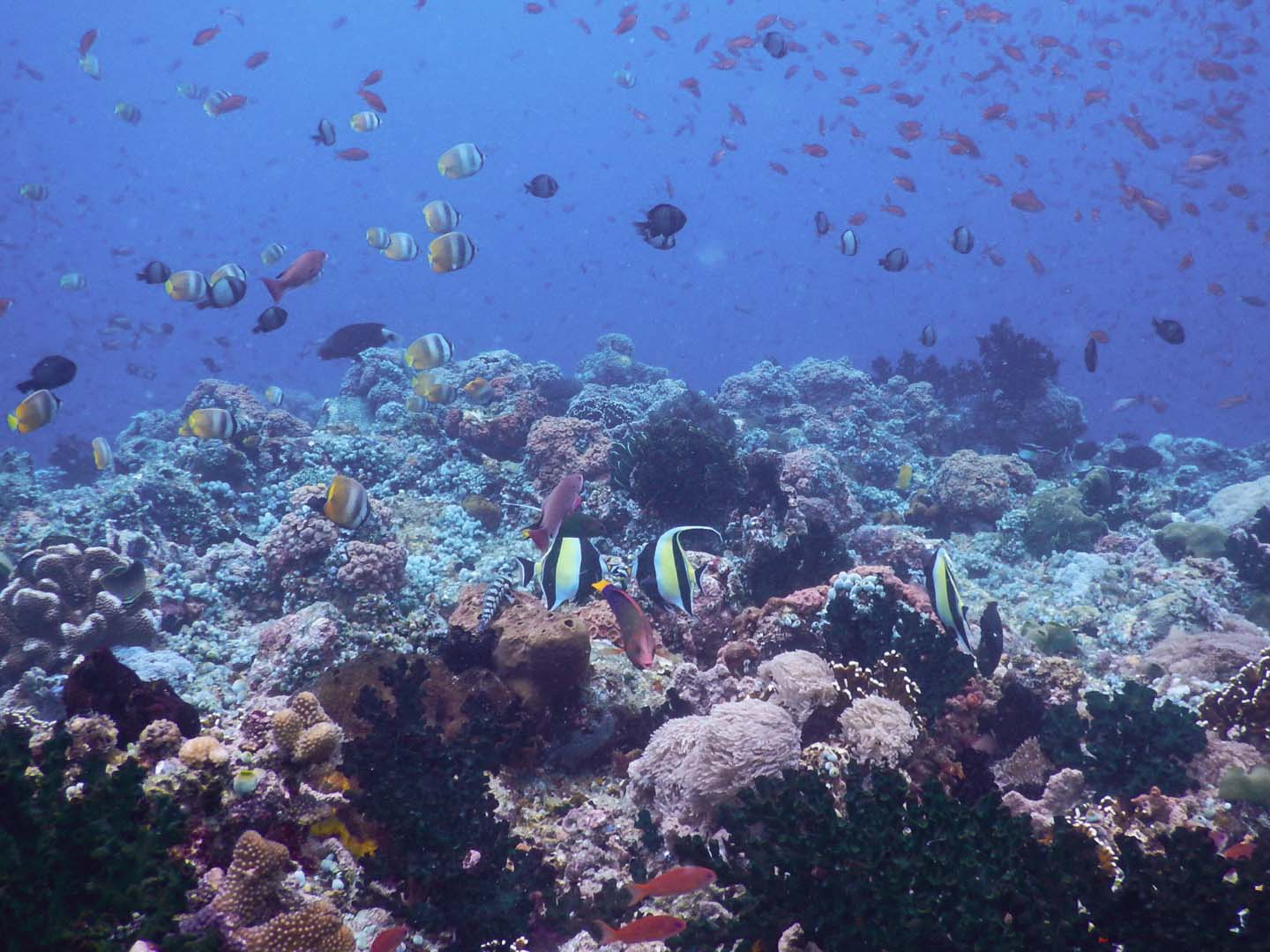Whether you’re a beginner or a seasoned diver, choosing the proper attire for scuba diving is essential to make the most of your dive.
Knowing what to wear for scuba diving is crucial for your comfort and safety underwater. From shielding you against cuts and abrasions in tight spaces to providing a barrier against dangerous sea creatures, your scuba diving suit plays a crucial role in your experience. Most importantly, it safeguards you from the impact of extreme water temperatures, ensuring a comfortable dive.
In this blog post, you will learn about the different exposure suits scuba divers wear. From wetsuits to drysuits and everything in between, find out what scuba diving attire you might need to wear for your next dive adventure.
1. Scuba Diving Wetsuits

A scuba wetsuit is a type of exposure suit made of neoprene, a synthetic rubber material that provides thermal insulation. The purpose of a wetsuit is to maintain body temperature and protect divers from the cold water while allowing flexibility and freedom of movement.
Aside from thermal protection, wetsuits can protect divers from other environmental elements. The wetsuit can serve as a barrier between your skin and any sharp rocks or surfaces, thus preventing cuts and abrasions. It can protect you from stinging or dangerous sea creatures. And it can also give you coverage against the harmful rays of the sun.
Wetsuits are suitable for a wide range of water temperatures, both warm and cool. The thickness of a wetsuit determines its insulation level, with thicker suits providing more warmth. For example, a 3mm wetsuit is great for warmer waters (25°C – 28°C or 77°F – 82°F), while a 5mm or 7mm wetsuit is better for colder conditions (21°C – 20°C or 70°F – 68°F)
When it comes to wetsuit lengths, there are two common options. Full suits cover the entire body from the neck down to the ankles, providing maximum coverage and warmth. Shorties, on the other hand, are shorter wetsuits that cover the torso and upper thighs, offering some insulation while allowing more freedom of movement.
The wetsuit works by trapping a thin layer of water against the skin. Your body heat warms this water, creating a protective barrier between your body and the surrounding cold water. This layer of water acts as insulation, slowing down heat loss and keeping you relatively warm throughout the dive.
2. Dry suits

A dry suit is a type of scuba diving attire that provides complete water isolation and keeps the diver dry during the dive. Unlike wetsuits, which rely on a thin layer of water trapped against the skin for insulation, drysuits are made of waterproof materials to keep water out.
A dry suit’s goal is to provide thermal protection and keep the diver dry in cold water. It is perfect for diving in extremely cold seas or scenarios requiring lengthy exposure to cold temperatures. Divers can keep warm and comfortable throughout the dive by wearing thermal undergarments inside their drysuit.
The primary distinction between a dry suit and a wetsuit is how they handle water. A wetsuit permits a tiny layer of water to enter the garment for insulation, whereas a dry suit keeps the diver totally dry by keeping water out.
In colder conditions, usually Below 10°C (Below 50°F), a dry suit outperforms a wetsuit in terms of thermal protection. It allows divers to wear varying combinations of insulation layers dependent on water temperature and personal choice.
Dry suits may be used for the purpose of controlling buoyancy and call for the use of additional weights due to the fact that they are significantly more buoyant than a wetsuit. Scuba divers who want to wear a dry suit should undergo Dry Suit Diving training to avoid any dive accidents.
3. Semi-Dry Suit

A semi-dry suit is another attire for scuba diving that provides more thermal insulation than a standard wetsuit. It combines elements of both wetsuits and drysuits, providing a compromise between the two.
A semi-dry wetsuit’s objective is to provide additional thermal protection in cooler water conditions while still allowing some water to enter. It seeks to limit water circulation within the suit in order to reduce heat loss and increase overall insulation.
Semi-dry suits are often used in water temperatures from 10°C – 15°C (50°F – 59°F). They’re a great option for divers who desire more warmth than a conventional wetsuit can provide but prefer the flexibility and fit of a wetsuit over a fully sealed drysuit.
The design and construction of a semi-dry wetsuit varies from that of a standard wetsuit. Semi-dry suits frequently have additional water-repellent components such as wrist and ankle seals, a better-fitting neck seal, and, in some cases, a zipper or flap system.
In comparison to a drysuit, a semi-dry suit allows some water to enter but at a slower rate. Drysuits entirely isolate the diver from the water, keeping him or her dry throughout the dive. A semi-dry wetsuit, on the other hand, allows only a small quantity of water to enter while harnessing the water’s insulating characteristics to offer warmth.
4. Additional thermal protection
In addition to wetsuits, drysuits, and semi-dry suits, scuba divers may wear additional thermal protection layers to enhance their insulation in colder water temperatures. Some of these additional thermal protection options include
Hoods

Divers wear dive hoods to provide thermal insulation and to protect their heads and necks from the cold water. They are normally made of neoprene, the same material as wetsuits, and come in a variety of thicknesses to fit the temperature of the water.
Divers use hoods to prevent heat loss from the head, which is a major source of heat dissipation in the body. Hoods serve to maintain body temperature and lower the danger of hypothermia by covering the head. They also offer additional protection against scrapes, scratches, and stings from sea life.
The main advantage of wearing diving hoods is the increased comfort and warmth during cold water dives. Many women divers also wear scuba hoods to keep their diving hair away from their faces.
On the other hand, it might limit your hearing, which can influence situational awareness underwater. It can also cause tightness or compression around the skull and face, which some divers may find unpleasant.
Proper fit and selecting the appropriate thickness for the water temperature are critical considerations for comfort and functionality.
Wetsuit vests / jackets

Wetsuit vests, also known as wetsuit tops or wetsuit jackets, are sleeveless or short-sleeved garments designed to be worn for additional insulation and protection to the torso area during scuba diving.
By covering the torso, they help retain body heat and prevent heat loss, keeping divers warmer during their dives. They can be easily added or removed as needed, allowing divers to adjust their thermal protection based on water conditions.
Dive Gloves

Gloves are worn by divers wear to protect their hands during scuba diving. They are often constructed of neoprene or a comparable material that offers thermal insulation as well as flexibility.
Dive gloves keep the hands from becoming cold or numb. They allow divers to keep their manual skills and accomplish activities like operating dive computers, modifying equipment, and signaling with greater ease.
Scuba diving gloves also provide an additional layer of protection, lowering the chance of injury such as cuts and scrapes from sharp underwater items. They also provide a superior grip, allowing divers to more efficiently handle equipment, rocks, or other surfaces.
In many places, especially in warm water regions, gloves are considered unnecessary accessories. Many dive shops and marine parks do not allow gloves to discourage divers from touching marine life.
Dive Socks

Dive socks, typically made of neoprene or a similar material, are worn by scuba divers on their feet for additional thermal insulation and protection. By preventing heat loss from the extremities, dive socks contribute to overall body temperature regulation.
Aside from keeping the feet warm, scuba socks can prevent blisters and chafing caused by direct contact with fins.
Booties

Scuba booties, also known as dive boots or wetsuit boots, are specialized footwear worn by divers during scuba diving. They cover the entire foot, including the sole and ankle.
The benefits of wearing scuba booties include increased comfort, improved traction, and foot protection. Booties help prevent blisters and chafing caused by direct contact with fins or other equipment.
They provide a better grip on slippery surfaces, both underwater and on shore. Additionally, booties offer ankle support, reducing the risk of sprains or injuries when walking on uneven terrain.
Similar to wetsuits, scuba booties are available in various thicknesses and styles to suit different diving conditions and personal preferences.
In addition to thickness, scuba booties come in different styles. Low-cut booties cover the foot but leave the ankle exposed. They offer more flexibility and are commonly used in warm water diving. High-cut Booties provide coverage up to the ankle or higher, offering better insulation and added protection. They are suitable for colder water diving or when extra ankle support is desired.
5. Other scuba diving outfits
Do you have to wear a wetsuit or drysuit when scuba diving?
Nope! You don’t have to.
While wetsuits, dry suits and semi dry suits are the usual attire for scuba divers, there are alternatives. Dive skins, rash guards, dive leggings, among many others can also be worn based on conditions and personal preference.
Dive Skins
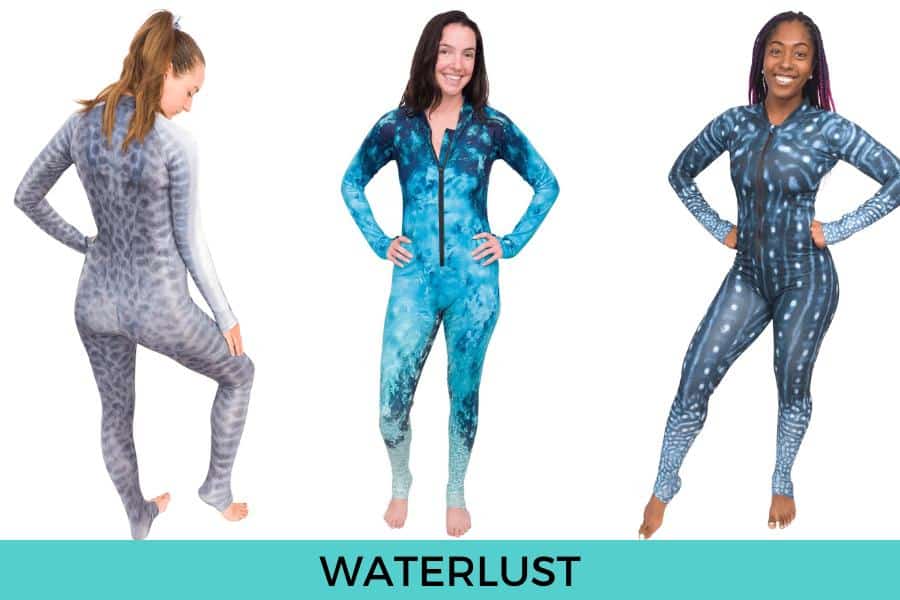
Tiger shark trailblazer full-body sun suit
Fountain of Youth full-body sun suit
Whale shark warrior full-body sun suit
Dive skins are form-fitting, one-piece suits made of lightweight and breathable materials. They are designed to be worn as a base layer under wetsuits or can be worn as is in warm-water diving conditions.
Made of Lycra or spandex blended with nylon or polyester, dive skins provide minimal insulation and primarily serve as a protective layer against various elements.
Dive skins are typically lightweight and easy to put on and take off, making them convenient for divers during gear preparation and post-dive activities.
If you are prone to chafing, dive skins are great for preventing them.
Dive skins are effective in shielding your skin from harmful UV rays while diving in sunny conditions. This protects against sunburn and reduces the risk of long-term sun damage.
Dive skins offer a barrier against jellyfish stings, sea lice, and other marine organisms that may cause irritation.
Scuba leggings
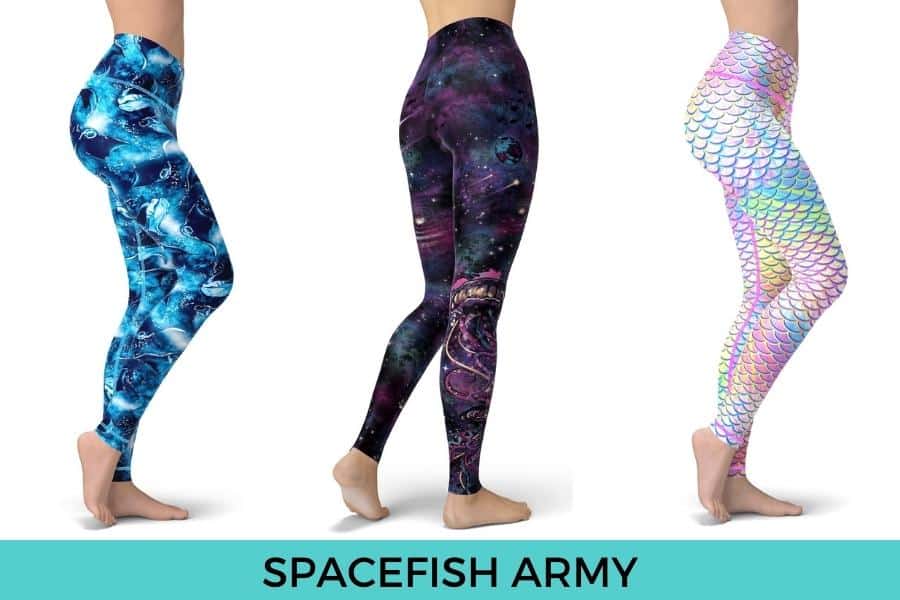
Manta Mayhem Leggings
Galaxy Jellyfish Leggings
Psychedelic Mermaid Leggings
Scuba leggings, also known as dive leggings or dive pants, are specialized garments designed for scuba diving. They are worn as a bottom layer under wetsuits or as standalone dive wear in warm water diving conditions.
They are form-fitting, lightweight, and typically made of stretchy materials like Lycra or spandex blended with nylon or polyester. The flexible and stretchy materials, allow divers to move freely in the water.
Dive leggings are great for protecting your legs from abrasions, stings and minor cuts while diving. They also offer sun protection.
When it comes to options on what to wear when scuba diving in warm waters, scuba leggings are a popular choice for women.
Here are some posts you should check out if you want to buy scuba leggings:
Best Scuba Leggings: 10 Brands To Help You Look Good While Diving
10 Best Whale Shark Leggings For Your Active Lifestyle
Rash guard
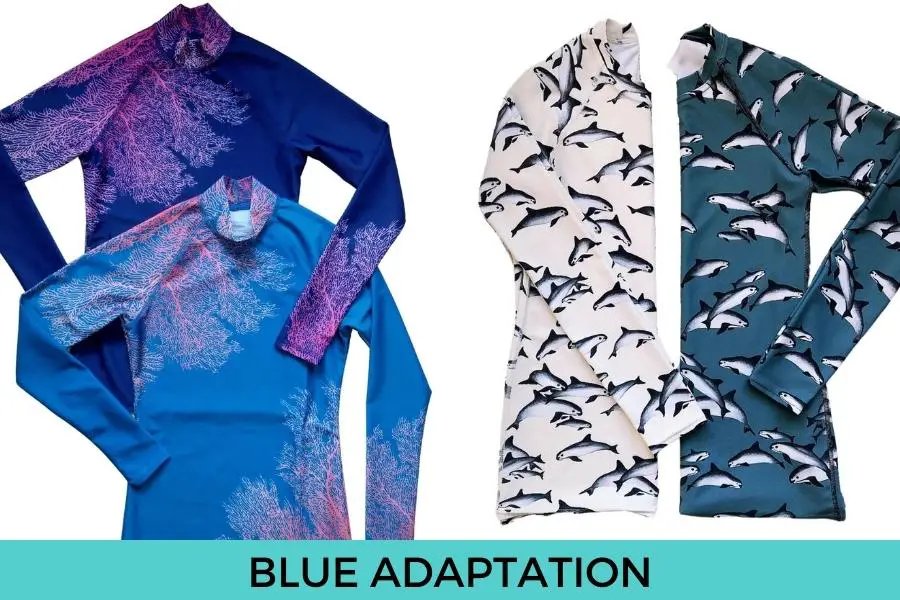
Coral reef sea fan high-neck dive rashguard
Save the vaquita crew-neck rashguard
Rash guards, also known as rash vests or rash shirts, are lightweight and quick-drying garments primarily used in water sports, including scuba diving. They are typically made of stretchy and breathable materials and are worn as a top layer.
The name “rash guard” comes from their ability to prevent rashes caused by friction against the skin, typically from equipment like wetsuits or dive gear. The smooth and tight-fitting fabric of rashguards reduces chafing and irritation, making them ideal for preventing rashes and discomfort during dives.
Rashguards are designed to dry quickly, allowing moisture to evaporate rapidly from the fabric. This feature helps maintain comfort during and after dives, as they do not retain excess water and remain lightweight even in wet conditions.
Rashguards are a popular choice for divers, particularly in warm-water environments, where sun protection, rash prevention, and comfort are essential. They are available in various designs, including short sleeves, long sleeves, and different patterns or colors, offering divers a range of options to suit their preferences and style.
Best Scuba Diving Rash Guards for Women of Different Styles, Shapes, and Sizes
Board shorts
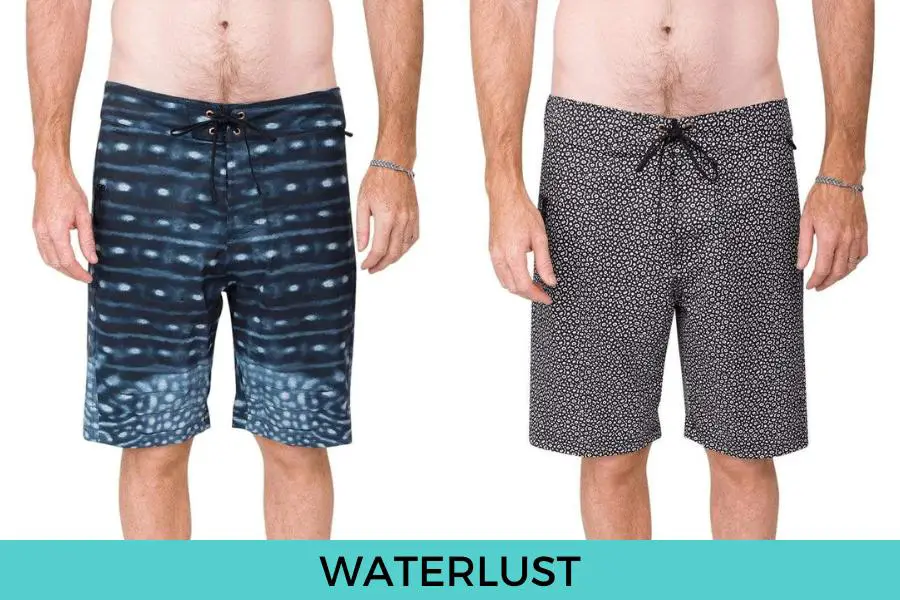
Whale shark board shorts
Spotted eagle ray board shorts
Board shorts are a type of swimwear that originated from surfing culture. Board shorts are known for their loose-fitting and knee-length design, featuring a lace-up or Velcro closure at the waist.
They are a popular scuba diving attire for men while diving in tropical warm waters. While they are not designed to keep the body warm, they do provide freedom of movement. The loose fit and length, allow divers to move their legs comfortably and perform various water activities without restrictions.
Board shorts can be worn both in and out of the water, making them a versatile option for divers. They are suitable not just for diving but also for post-dive activites like swimming, snorkeling, or simply relaxing on the beach.
Swimsuits
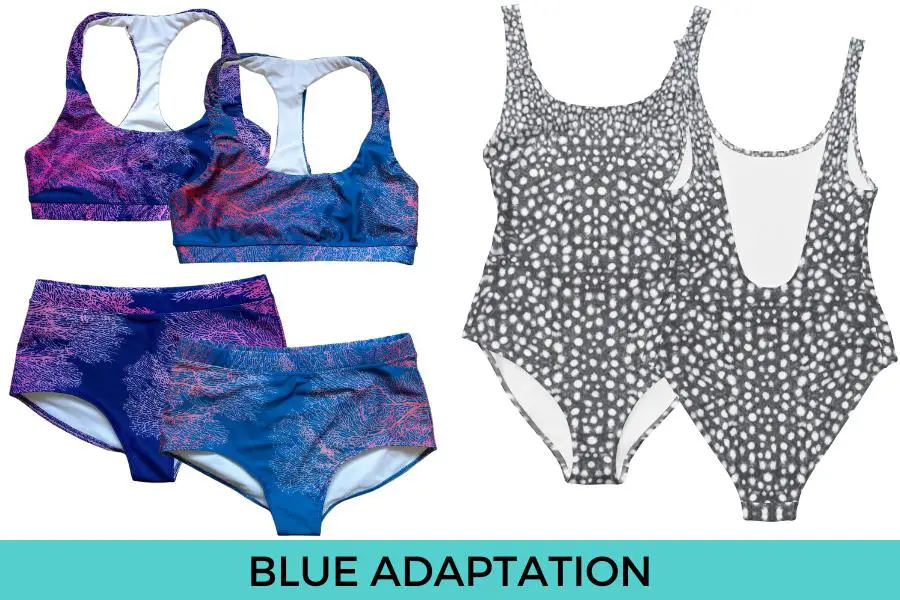
Coral sea fan racerback bikini top
Coral sea fan bikini bottom
Hi-tide whale shark swimsuit
Scuba divers can also go diving in just their swimsuits. Often times you’ll see divers in just their bikinis, tankinis, or one-piece suit.
While it is possible for divers to wear swimsuits or bathing suits alone while diving, it is generally not recommended since it leaves your body completely exposed to harmful elements and potential hazards.
Recommended scuba diving attire based on water temperature
Here are some recommendations on what to wear when scuba diving in specific water temperatures.
| Water Temperature (°C) | Water Temperature (°F) | Recommended Scuba Diving Suit |
|---|---|---|
| 25°C – 28°C | 77°F – 82°F | 3 mm wetsuit |
| 21°C – 25°C | 70°F – 77°F | 5 mm wetsuit |
| 15°C – 20°C | 59°F – 68°F | 7 mm wetsuit |
| 10°C – 15°C | 50°F – 59°F | Semi-dry suit |
| Below 10°C | Below 50°F | Dry-suit |
It’s important to note that these are just suggestions and approximations. What you wear while scuba diving can vary depending on individual factors such as tolerance to cold, wind speed, air temperature, and personal preference.
If you tend to get cold easily or the conditions are particularly windy, it’s advisable to choose a wetsuit with a slightly higher thickness than recommended in the table. Additionally, you can enhance your thermal protection by adding gloves, booties, a vest, and a hood to your scuba diving gear.
